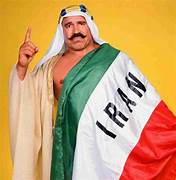For this week’s reading, I chose to look at chapter eleven of The Tennessee Test of Manhood’: Professional Wrestling and Southern Cultural Stereotypes.” Overall, I found myself absolutely loving this reading due to a plethora of great approaches taken by the author. However, I think the most effective approach was the way in which the text presented the power of cultural stereotypes in wrestling. Specifically, the text was able to examine cultural stereotypes across different eras of American society through the binary opposition of heroes and villains in wrestling.
I think the strongest example of this in the text is the presentation of the wrestler Seargent Slaughter. The text first presents the character as a cruel villain who was known for “‘excessive cruelty to his troops in boot camp’”. Despite this absolutely deplorable characterization, the character is still able to make the shift into a hero in the face of the Iranian hostage crisis. They achieve this by embracing a more patriotic portrayal of him as well as attaching him to a rivalry with the Iron Shiek who would, “incite the crowd by waving a large Iranian flag, and Slaughter would promise that upon his defeat, the villain would ‘kiss my combat boots’”. Here, we see that by attaching to such a stereotypical depiction of an Iranian hostile, the promotion is able to use both American militaristic patriotic sentiments as well as xenophobic sentiments in order to completely alter an established villainous character into someone spectators could rally around. This shows the complete and total power that cultural stereotypes had over American society at this time period.


As for finding problems I had with the author’s approach, I actually had a tough time thinking of flaws as I felt the author did an excellent job in exploring the topic. The only thing I could think of was the image choice did feel somewhat lacking. While the images did do a great job of showing off some of the wrestlers they talk about, I do feel that the text could have utilized images depicting some of what these wrestling events and matches actually looked like. As well, I wish that during some of the parts of the characters with clashing cultural stereotypes such as Iron Shiek and Seargent Slaughter or Hunter Hearst-Helmsley and Henry Goodwin they had put pictures of the characters side by side in order to highlight the impact the stereotypes had.